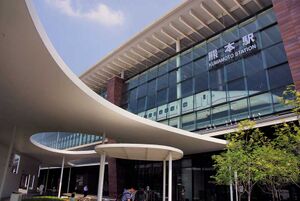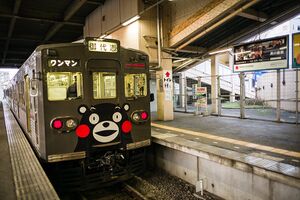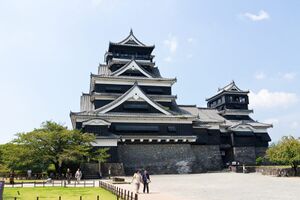Kumamoto
| Kumamoto | |||||
|---|---|---|---|---|---|
| Japanese Name | クマモト | ||||
| Weapon | |||||
| Race | Beast | ||||
| Nationality | |||||
| Birthday | July 1 | ||||
| Constellation | Cancer | ||||
| Talents | Sumo wrestling | ||||
| Likes | People with dignity, Karashi renkon | ||||
| Dislikes | Talkative people | ||||
| Strengths | Overwhelming strength, High endurance | ||||
| Weaknesses | Unable to clearly express her opinions | ||||
| Hobbies | Playing with wild animals | ||||
Kumamoto. Assigned to the M. Nishiki Railway Army. Kuma has great respect for the spellcaster Miyako-san. Kuma too, wants to be as cool as Miyako-san. Want to be able to fight with dignity. Conductor-sama, please teach Kuma how to fight cool, okay?
Layers
| Icon | Title | Release Date | Where to Obtain |
|---|---|---|---|
| [Mighty Bear Beastkin] Kumamoto | 2022 August 16 | [Liar Lunar World Trip] Pick Up Gacha, Premium Gacha | |
| [Protector of Children] Kumamoto | 2023 January 24 | [Sweet Tooth Goddess and the Sickly Magician] Limited Gacha | |
| [World's Most Fortunate Person] Kumamoto | 2023 January 16 | [Buried Gold and Crow's Treasure] Pick Up Gacha, Premium Gacha |
Owned Skills
Trivia
- Kumamoto's birthday is the opening date of Kumamoto (JR) station in 1891.
- Kumamoto draws inspiration from the Japanese folk hero Kintaro, a powerfully strong but simple-minded boy often seen carrying an axe and riding a bear. She also wears a red haragake apron resembling Kintaro's in [World's Most Fortunate Person].
- Kumamoto's beast motif is the bear. The current Japanese orthography for Kumamoto (熊本) literally means "bear root/origin", or "origin of the bear".
- In addition, Kumamon is a cartoon character of a rosy-cheeked brown bear designated as the official mascot of the Kumamoto prefecture in Japan. Since its debut in early 2011 as part of a tourism promotion campaign, Kumamon has become a popular character nationwide and even inspired a reaction image featuring the mascot with a mischievous grin reminiscent of the Disaster Girl on the English-speaking web, known by the meme "For the glory of Satan, of course". In November 2011, Kumamon was voted the most popular mascot in Japan with more than 287,000 votes in an online poll for the annual Yuru-Kyara Grand Prix.
- Karashi renkon (辛子蓮根, spicy lotus root) is one of Kumamoto's regional foods and it is a must-serve dish for all kinds of ceremonial occasions in Kyushu regions. It is a mixture of miso and Japanese karashi (hot mustard) stuffed in lotus root, coated in turmeric flour batter, and deep-fried until a crispy crust forms.
Counterpart
Kumamoto Station (熊本駅, Kumamoto-eki) is the main railway terminal of the city of Kumamoto, Japan. It is located in Nishi-ku, Kumamoto, and is operated by Kyushu Railway Company (JR Kyushu). In front of the station is a tram stop of the tram operated by Kumamoto City Transportation Bureau named Kumamoto-Ekimae Station. It is the representative station of Kumamoto City, a government-designated city and the capital of Kumamoto Prefecture, and is the railroad hub and land gateway in Kumamoto. It is a terminal station where all passenger trains stop, including the Mizuho and Sakura trains that go directly to Shin-Osaka Station on the Sanyo Shinkansen Line of the Kyushu Shinkansen, the Tsubame trains that run within Kyushu, and limited express and sightseeing trains on conventional lines bound for Aso and Hitoyoshi (which are suspended due to the heavy rain disaster).
Kumamoto station first started with its engine depot established in April 1891, and the station opened officially as a Kyushu Railway station in Kasuga, Akuta on July 1 of the same year, at the same time as the extension of the line between Tamana and Kumamoto (the following year, the same county is merged with Komasa and becomes part of Akuta). By August 11, 1894, the station is connected to Kawajiri Station via the Kyushu Railway Line. Due to nationalization of Kyushu Railways, the station becomes a station of the Imperial Railway Agency on July 1, 1907. The old station is then demolished and the new station relocated (to the current location) on July 1914 onwards. On July 27, 1945, the upper house of the station burned down in the air raid on Kumamoto. The station bookstore was not damaged. The station was remodeled by 1958.
Kumamoto station is an elevated station with two 6-lane island-type platforms for the conventional lines and two 4-lane island-type platforms for the Shinkansen lines. The Shinkansen platforms can accommodate up to 8-car trains and are equipped with movable safety barriers (platform doors). The station is designed to accommodate up to 16-car trains, and the roadbed is ready for 12-car trains to the north of this station (some work is in preparation). The conventional lines began operating with partially elevated platforms (platforms 4-6) on March 14, 2015, and the station was fully elevated on March 17, 2018. With the completion of the elevated line, the underground passageway (inside the ticket gates and free passage) connecting the west and east exits was closed and backfilled with the demolition of the old station building. The third floor and above of the old station building was business space for JR Kyushu Kumamoto Branch and other JR Kyushu-related companies, but with the demolition of the old station building, it was moved to a nearby elevated area. There is also a Family Mart inside the Shinkansen ticket gates.
On March 12, 2011, the train yard was relocated to the south with the full opening of the Kyushu Shinkansen line. The original station building on the conventional line side (east exit) was named "Shirakawa-guchi" and the newly built west exit was named "Shinkansen-guchi"; the elevation of the conventional line was completed on March 17, 2018, and the current station building was completed on March 16 the following year. The Shirakawa Exit (East Exit), the main entrance, was designed by architect Tadao Ando and was inspired by the "Musha-gaeshi," the stone wall of Kumamoto Castle. Around the time of the elevated railroad line, a number of redevelopment projects, including a station square, were underway in the surrounding area. The station building-type commercial facility (fashion building), "JR Kumamoto City," centered on "Amu Plaza Kumamoto," opened on April 23, 2021. Wikipedia
Kumamoto Castle (熊本城) is a hilltop Japanese castle located in Chūō-ku, Kumamoto, in Kumamoto Prefecture. It was a large and well fortified castle. The castle keep (天守閣) is a concrete reconstruction built in 1960, but several ancillary wooden buildings remain of the original castle. Kumamoto Castle is considered one of the three premier castles in Japan, along with Himeji Castle and Matsumoto Castle. Thirteen structures in the castle complex are designated Important Cultural Property.
Kumamoto Castle's history dates to 1467, when fortifications were established by Ideta Hidenobu. In 1496, these fortifications were expanded by Kanokogi Chikakazu. In 1588, Katō Kiyomasa was transferred to the early incarnation of Kumamoto Castle. From 1601 to 1607, Kiyomasa greatly expanded the castle, transforming it into a castle complex with 49 turrets, 18 turret gates, and 29 smaller gates. The smaller castle tower, built sometime after the keep, had several facilities including a well and kitchen. In 1610, the Honmaru Goten Palace was completed. The castle complex measures roughly 1.6 kilometres (0.99 mi) from east to west, and measures 1.2 kilometres (0.75 mi) from north to south. The castle keep is 30.3 metres (99 ft) tall.
The castle was besieged in 1877 during the Satsuma Rebellion, and the castle keep and other parts were burned down. 13 of the buildings in the castle complex were undamaged, and have been designated Important Cultural Properties. In 1960, the castle keep was reconstructed using concrete. From 1998 to 2008, the castle complex underwent restoration work, during which most of the 17th century structures were rebuilt. The signature curved stone walls, known as musha-gaeshi, as well as wooden overhangs, were designed to prevent attackers from penetrating the castle. Rock falls were also used as deterrents.
The castle sustained damage in a magnitude 6.2 earthquake that struck at 9:26 pm on 14 April 2016, in Mashiki town in Kumamoto prefecture. This event is substantially similar to the 1889 Kumamoto earthquake which also damaged the castle. While the keep itself withstood most of the earthquake with little structural damage, two of the castle's turrets were severely damaged and partially collapsed, more of the exterior walls at the foot of the keep also collapsed, and large amounts of kawara roof tiles on the keep's roof were also disrupted and fell from the roof as a result of the quake. As of June 8, 2016, the efforts to repair the castle have begun. The restoration of the main tower will be completed by 2019. The restoration of the Nagabei Wall was completed in January, 2021. The repair and restoration of the entire castle is scheduled for completion by the year 2036. Wikipedia
Map
Gallery
- Pages using Tabber parser tag
- Pages using DynamicPageList3 parser tag
- Weapon Axe
- Beast
- Nishiki
- Cancer
- Element Cut
- Element Wind
- Element Fire
- Metro Train Knights
- Japan











